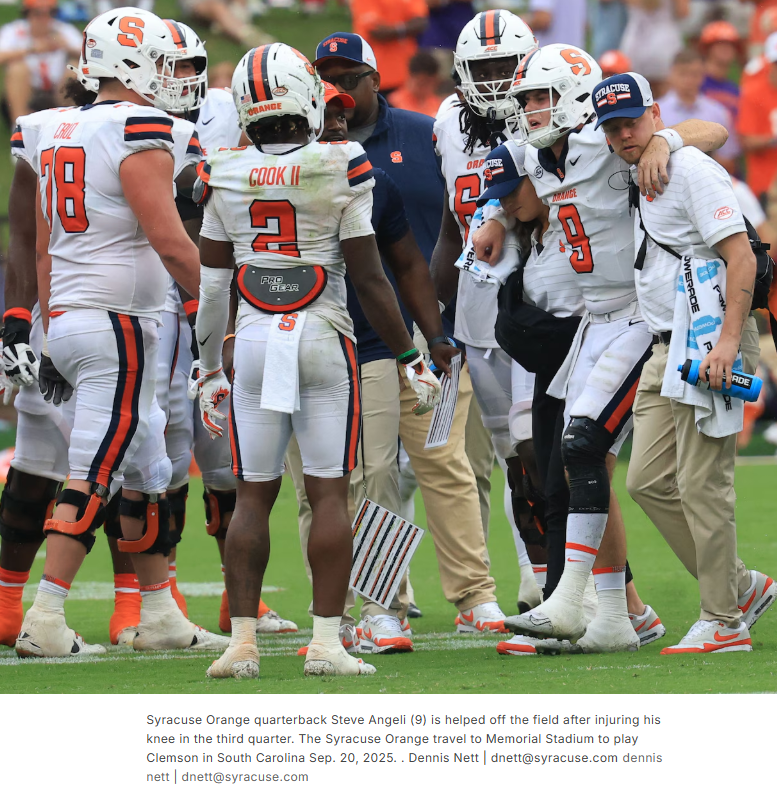Syracuse, N.Y. — Syracuse football coach Fran Brown is hoping Steve Angeli will be far enough along in his recovery from a torn Achilles tendon that he’ll be ready to participate when the Orange begins spring practices for 2026.
That would mean a recovery timeline of just over six months. A spring return would be ideal for Syracuse and is the most optimistic goal for the quarterback.
Recovery from a torn Achilles tendon can last anywhere from six to 12 months due to a variety of unpredictable factors, Syracuse’s head orthopedic surgeon Todd Battaglia said on Monday.
Neither Battaglia, nor Brown, would say if Angeli suffered a complete tear of his Achilles. However, Battaglia said the majority of Achilles tears in athletes are complete tears.
“You lose all ability to push off with your foot,” Battaglia said. “Your calf muscle is not connected to your foot anymore. So, you can’t stand on your toes, you can’t push off with your foot, you can’t run. In fact, it’s pretty darn hard to even walk with an Achilles tendon rupture.”
Most Achilles tears are a result of tendonitis in the area, Battaglia said. Tendonitis is normally undetected by athletes until the tear.
He said in nearly all instances athletes with a ruptured Achilles will say they hadn’t felt any pain until the push-off that led to the tear.
“You can maybe do some things to maybe lower your chances,” Battaglia said. “But there isn’t really any telltale sign that says you’re headed for an Achilles rupture. It really is just sort of bad luck when it happens.”
Most athletes undergo one of two surgeries, Battaglia said.
One surgery consists of doctors manually reattaching the two ends of the Achilles tendon. The other repair involves using a device to reattach the tendon through a small incision of the skin.
Battaglia did not say which option Angeli chose to undergo Monday. He said reinjury rates for a torn Achilles are around five percent.
The recovery process for Angeli will depend on the strength of his calf muscle. When the Achilles ruptures, the calf atrophies rapidly. Battaglia said that once the Achilles tendons are reattached and finish healing, the rest of their rehab consists of regaining their calf strength.
“There’s two stages to it,” Battaglia said. “The first stage where we’re really protecting it and letting the tendon heal, that’s the first few months. After that, it sort of transitions into this phase of trying to get the flexibility and the strength back.”
Angeli will be in either a splint or a cast for three-to-six weeks, leaving his “ankle completely immobile.” After that, he will transition into a walking boot.
Once Angeli is in the boot, he will begin physical therapy to work on his range of motion. That will include work with resistance bands and exercises like seated calf raises to increase his strength.
Battaglia said athletes don’t begin running again until they are about four-to-six months into their recovery. How Angeli’s body responds to the early rehab phases will determine when he begins running, which will clear up the timeline of his return to the field.
“There’s some factors that we really can’t control,” Battaglia said. “How much muscle weakness they develop, how much ankle stiffness they develop after surgery.”
The most optimistic timeline would put Angeli in the early phases of his rehab when Syracuse traditionally begins spring practice.
Angeli will probably begin running on an underwater treadmill, which allows athletes to run without using their full body weight.
“There’s different ways to use it,” Battaglia said. “Some of the pools and stuff you can put a current in there so you’re running against resistance. But there are other machines that are very small chambers and just depending on how much you fill it, you can fill it to the patient’s chest level with water, and it’ll take a whole bunch of their body weight off.”
Battaglia said he usually doesn’t allow an athlete use more than half their body weight when they begin running.
Angeli’s countdown began Monday, and Battaglia said the more days per week spent rehabbing, the better.
Syracuse seems all in on that plan as head coach Fran Brown said Monday that Angeli has been set up with online classes. That will allow Angeli to focus on his recovery and be around the team as much as he is able.

